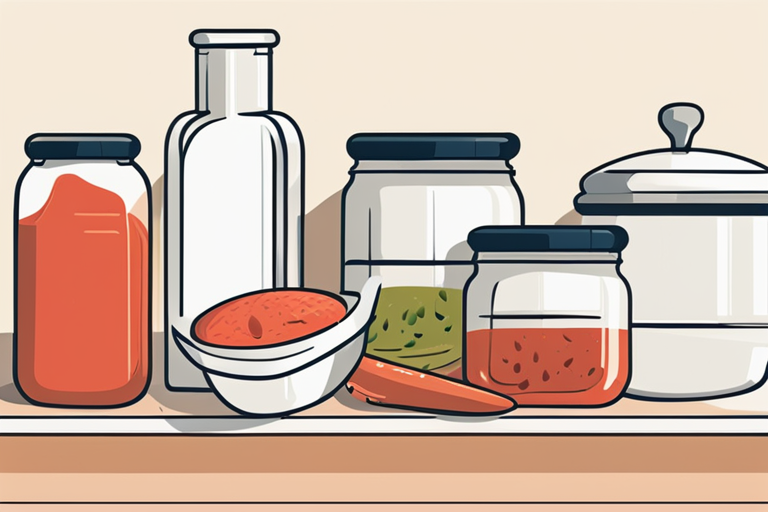
The Ultimate Guide to Food That Doesn't Need Refrigeration
Get Your Free Food Safety Cheat Sheet
30 most common foods with instant answers. Print it and stick it on your fridge—completely free!
The Ultimate Guide to Food That Doesn't Need Refrigeration
In our modern world, refrigeration has become a staple in most households to keep food fresh and safe for consumption. However, there are certain foods that don't require refrigeration and can be stored at room temperature without any issues. Understanding which foods fall into this category can help you save space in your fridge and reduce food waste. In this comprehensive guide, we will explore various types of non-perishable foods that can safely be stored outside the refrigerator.
Benefits of Non-Refrigerated Foods
Non-refrigerated foods offer several advantages, including:
- Convenience: You can stock up on non-perishable foods without worrying about limited fridge space.
- Long Shelf Life: Many non-refrigerated foods have a long shelf life, making them ideal for emergency preparedness or camping trips.
- Cost-Effective: Non-perishable foods are often more affordable and can be bought in bulk without the need for immediate consumption.
Categorizing Non-Refrigerated Foods
Non-refrigerated foods can be broadly categorized into the following groups:
Pantry Staples
Pantry staples are dry goods that can be stored in a cool, dark place like a pantry or kitchen cabinet. Some common pantry staples include:
- Rice
- Pasta
- Canned Beans
- Flour
- Sugar
Fresh Produce
Certain fruits and vegetables do not require refrigeration and can be stored at room temperature. Examples include:
- Bananas
- Tomatoes
- Potatoes
- Onions
- Citrus Fruits
Condiments and Spices
Many condiments and spices are shelf-stable and do not need refrigeration. These include:
- Vinegar
- Honey
- Salt
- Pepper
- Hot Sauce
Baked Goods
Certain baked goods have a longer shelf life and can be stored outside the fridge. Examples include:
- Bread
- Crackers
- Cookies
- Cereal
Safety Tips for Storing Non-Refrigerated Foods
While non-perishable foods can be stored at room temperature, it's essential to follow some safety tips to ensure they remain safe for consumption:
- Check Expiry Dates: Always check the expiry dates on non-refrigerated foods and discard any expired items.
- Store in airtight containers: Transfer pantry staples like flour, rice, and sugar into airtight containers to prevent pests and moisture.
- Keep in a cool, dark place: Store non-refrigerated foods away from direct sunlight and heat sources to maintain their quality.
- Rotate Stock: Practice first in, first out (FIFO) rotation to use older items before newer ones to prevent spoilage.
Conclusion
In conclusion, understanding which foods do not require refrigeration can help you optimize your kitchen storage and reduce food waste. By categorizing non-refrigerated foods, following safety tips, and utilizing proper storage techniques, you can enjoy the convenience and benefits of stocking up on pantry staples, fresh produce, condiments, and baked goods without the need for refrigeration. Incorporate these non-perishable foods into your meal planning and emergency preparedness to ensure a well-stocked and diverse pantry.

Authoritative Food Safety References
These agencies and university labs inform every tip and health precaution we publish.
USDA FoodKeeper – Cold Storage Guidelines
Official refrigerator, freezer, and pantry timelines maintained by the U.S. Department of Agriculture.
Visit USDA FoodKeeperFDA Produce Safety Rule & Grower Guidance
Field-to-fridge handling practices that prevent contamination of fruits, vegetables, and leafy greens.
Visit FDA Produce SafetyCDC Foodborne Illness Prevention Hub
Surveillance-backed guidance on pathogens, symptoms, and steps to reduce foodborne illness risk.
Visit CDC Food SafetyUC Davis Postharvest Technology Center
University research detailing optimal storage atmospheres for produce after harvest.
Visit UC Davis PostharvestPenn State Extension – Home Food Preservation & Safety
Peer-reviewed extension bulletins on safe canning, chilling, and reheating practices.
Visit Penn State ExtensionCan I store eggs outside of the refrigerator?
How long can canned foods last without refrigeration?
Is it safe to consume unrefrigerated cheese?
Can fruits and vegetables be stored without refrigeration?
How should leftovers be stored without refrigeration?
Get Your Free Food Safety Cheat Sheet
30 most common foods with instant answers. Print it and stick it on your fridge—completely free! Want more? Upgrade to the complete guide with 70+ foods.
Scan your food directly and get instant safety info using our AI-powered camera feature.